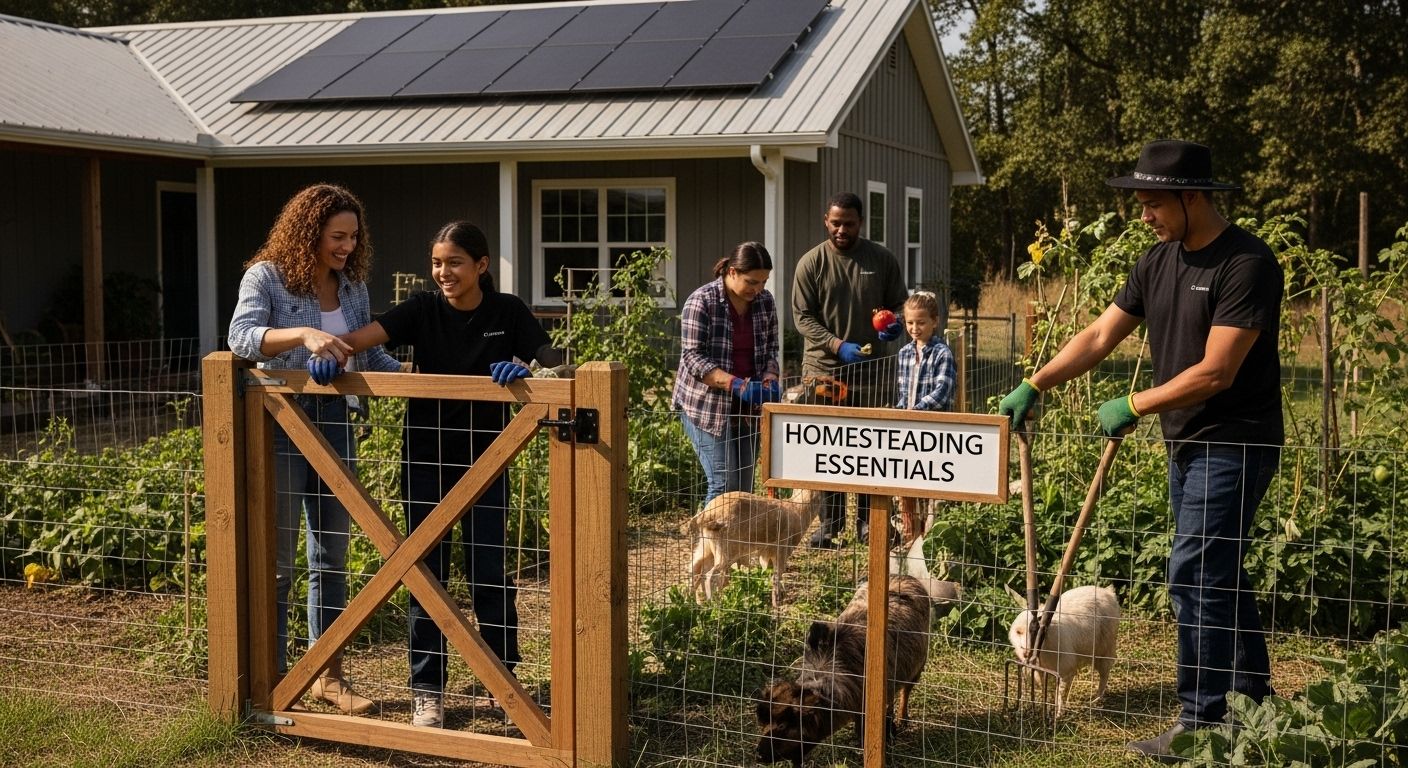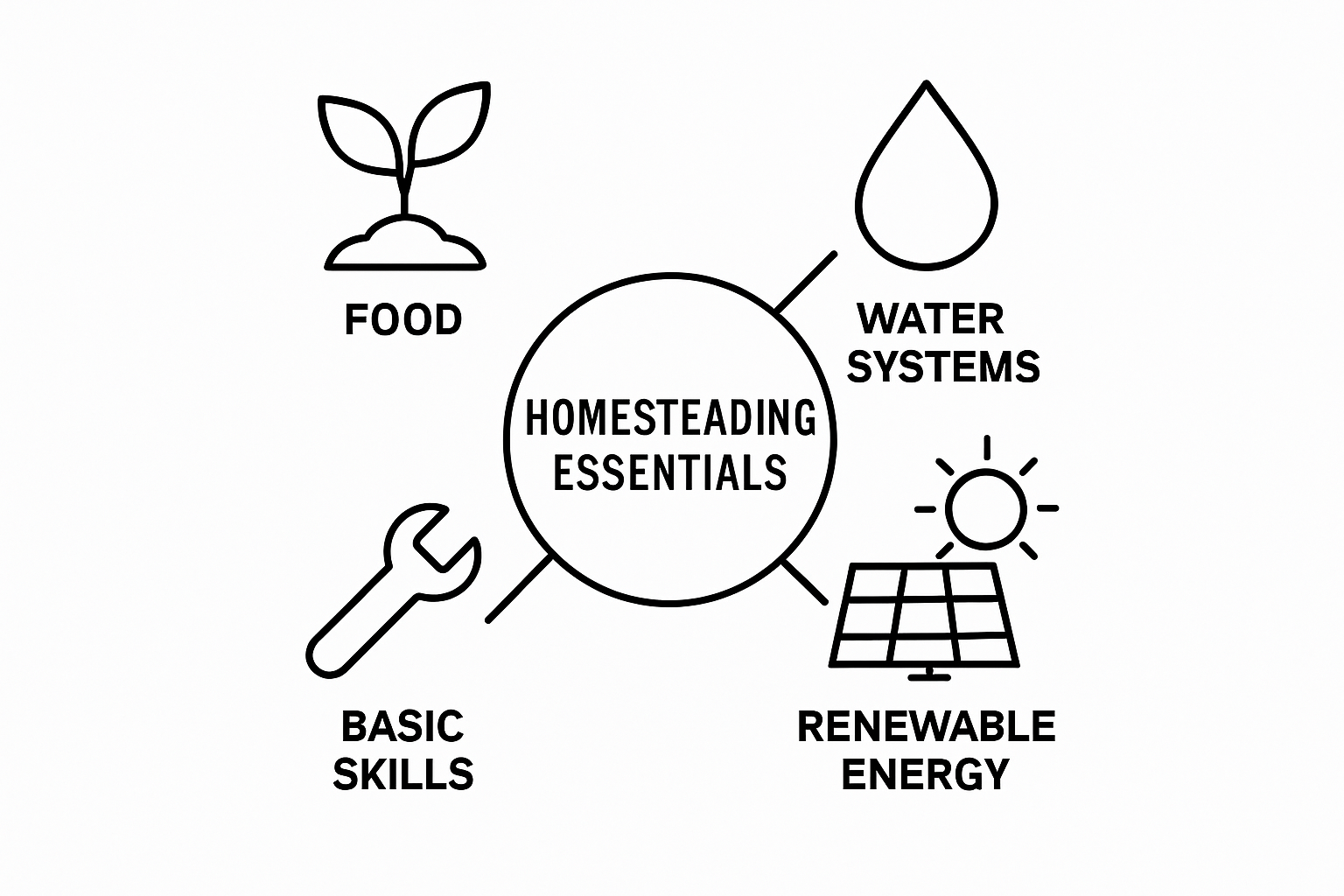
Homesteading is attracting more people each year with its promise of self-sufficiency and living closer to the land. You might assume it is just about growing your own tomatoes or raising backyard chickens, but guess what. Homesteading success depends just as much on technical knowledge as it does on manual labor. This shift in focus turns homesteading from a nostalgic hobby into a modern skillset that challenges everything you think you know about living off the grid.
Table of Contents
- Defining Homesteading Essentials: What You Need To Know
- The Importance Of Homesteading Essentials In Modern Life
- Key Components Of Successful Homesteading: Resources And Tools
- Connecting With Nature: The Role Of Sustainability In Homesteading
- Learning From Experience: Real-World Applications Of Homesteading Essentials
Quick Summary
| Takeaway | Explanation |
|---|---|
| Homesteading promotes self-sufficiency and sustainability | It encourages individuals to be independent by producing their own food and resources while minimizing waste. |
| Develop practical skills for successful homesteading | Essential skills include gardening, food preservation, and basic mechanical repair, fostering resilience and adaptability. |
| Embrace ecological stewardship in homesteading | Practitioners should integrate sustainable practices that enhance biodiversity and promote natural resource conservation. |
| Build a strong homestead infrastructure | Reliable water systems, renewable energy sources, and flexible living spaces are critical for effective homesteading. |
| Engage with the homesteading community | Sharing knowledge and experiences with others accelerates learning and helps tackle challenges collectively. |
Defining Homesteading Essentials: What You Need to Know
Homesteading represents a comprehensive lifestyle focused on self-sufficiency, sustainability, and reconnecting with traditional agricultural practices. At its core, homesteading transforms living spaces into productive environments where individuals generate their own food, resources, and energy through strategic planning and practical skills.
To help clarify the distinct pillars of successful homesteading, the table below outlines the four essential areas and summarizes their significance.
| Essential Component | Purpose in Homesteading |
|---|---|
| Self-Sufficiency | Reduces dependence on external food, energy, and resource systems |
| Practical Skills Development | Builds adaptability through gardening, repair, and food storage |
| Ecological Stewardship | Supports biodiversity and conserves natural resources |
| Homestead Infrastructure | Provides reliable water, energy, and adaptable living spaces |
The Core Philosophy of Homesteading
Homesteading goes beyond simple farming or gardening. It encompasses a holistic approach to living that prioritizes personal independence and reduced reliance on external systems. Practitioners aim to create closed-loop systems where waste is minimized, resources are maximized, and ecological balance is maintained. According to University of Illinois Extension, this lifestyle involves developing diverse skills that range from food production to resource management.
Key characteristics of successful homesteading include:
- Producing a significant portion of personal food requirements
- Generating renewable energy
- Practicing sustainable land management
- Developing practical skills like preserving food, animal husbandry, and crafting
Essential Skills and Mindset
Successful homesteading requires more than just land and equipment. It demands a specific mindset characterized by resilience, creativity, and continuous learning. Practitioners must be willing to adapt, problem solve, and invest time in developing practical skills. Technical knowledge becomes just as important as physical labor.
While every homestead looks different, most require fundamental competencies such as:
- Basic carpentry and repair skills
- Understanding of agricultural cycles
- Knowledge of local ecosystem and climate patterns
- Basic veterinary and animal care techniques
If you are interested in diving deeper into agricultural foundations, read more about starting your farming journey.
The Importance of Homesteading Essentials in Modern Life
In an era of increasing environmental uncertainty and global economic volatility, homesteading has emerged as a powerful strategy for personal resilience and sustainable living. This approach transcends traditional agricultural practices by offering individuals a comprehensive framework for independence, resource management, and ecological stewardship.
Economic and Personal Resilience
Homesteading provides critical buffers against economic instability and supply chain disruptions. By developing skills to produce food, generate energy, and create essential resources, individuals reduce their dependence on external systems. According to FAO research, self-sufficient practices can significantly enhance household economic stability and reduce vulnerability to market fluctuations.
Key economic advantages of homesteading include:
- Reduced grocery and utility expenses
- Decreased reliance on commercial food systems
- Enhanced personal skill development
- Potential for supplemental income through surplus production
Environmental and Ecological Impact
Beyond personal benefits, homesteading plays a crucial role in environmental conservation. Sustainable land management practices inherent in homesteading contribute directly to ecosystem health and biodiversity preservation. Practitioners typically employ methods that minimize waste, promote soil regeneration, and support local ecological systems.
Environmental benefits encompass:
The following table compares the economic and environmental advantages of homesteading as discussed in the article for quick reference.
| Advantage Type | Key Benefit | Explanation |
|---|---|---|
| Economic | Reduced Expenses | Lower grocery and utility bills through self-production |
| Economic | Decreased Reliance on Markets | Independence from commercial food and supply chains |
| Economic | Enhanced Skill Development | Broadens abilities and supports adaptability |
| Economic | Supplemental Income | Earning potential from selling surplus products |
| Environmental | Reduced Carbon Footprint | Limits emissions by sourcing locally and sustainably |
| Environmental | Conservation of Resources | Promotes efficient water, soil, and energy use |
| Environmental | Protection of Biodiversity | Sustains diverse plants, animals, and insects |
| Environmental | Promotion of Regenerative Agricultural Practices | Improves soil health and ecosystem resilience |
- Reduced carbon footprint
- Conservation of natural resources
- Protection of local biodiversity
- Promotion of regenerative agricultural practices
If you are interested in understanding more about sustainable land management, learn about property boundaries and land use strategies.
Key Components of Successful Homesteading: Resources and Tools
Successful homesteading requires strategic planning, specialized equipment, and a comprehensive understanding of resource management. Unlike traditional farming, homesteading demands versatility and adaptability across multiple domains of self-sufficient living.
Essential Infrastructure and Equipment
Building a functional homestead begins with establishing robust infrastructure that supports multiple aspects of sustainable living. Core infrastructure includes reliable water systems, renewable energy sources, and flexible living spaces. According to FAO guidelines, small-scale agricultural success depends on selecting appropriate tools and infrastructure tailored to specific environmental conditions.
Critical infrastructure components include:

- Reliable water collection and filtration systems
- Solar or wind energy generation capabilities
- Multipurpose storage and preservation facilities
- Adaptable living and working spaces
Skill Development and Resource Management
Homesteading transcends mere equipment acquisition. It requires continuous learning and skill development across agricultural, technical, and survival domains. Practitioners must develop expertise in areas ranging from soil management to mechanical repair, creating a holistic approach to self-sufficiency.
Key skill development areas include:
- Advanced gardening and crop management techniques
- Basic veterinary and animal husbandry skills
- Mechanical repair and tool maintenance
- Food preservation and long-term storage methods
If you are interested in exploring agricultural foundations in more depth, check out our comprehensive guide to starting a farm.
Connecting with Nature: The Role of Sustainability in Homesteading
Sustainability represents more than an environmental strategy in homesteading. It embodies a profound philosophical approach that reconnects humans with natural ecosystems, transforming agricultural practices into regenerative and symbiotic interactions.
Ecological Interconnectedness
Sustainable homesteading recognizes that human activities are intrinsically linked with broader ecological systems. Practitioners understand that every agricultural action creates ripple effects throughout local and global environments. According to research in Agriculture and Human Values, this holistic perspective shifts traditional farming from extractive practices to collaborative ecosystem management.
Key principles of ecological interconnectedness include:
- Mimicking natural biological cycles
- Promoting biodiversity
- Minimizing external resource inputs
- Enhancing soil health and regeneration
Holistic Environmental Stewardship
Homesteaders embrace a comprehensive approach to environmental interaction that extends beyond simple resource extraction. By integrating permaculture principles, practitioners create resilient systems that support both human needs and broader ecological networks. This approach transforms agricultural spaces into dynamic, self-regulating environments that generate abundance while maintaining ecological balance.
Environmental stewardship strategies encompass:
- Implementing crop rotation techniques
- Developing natural pest management approaches
- Creating wildlife habitats within agricultural landscapes
- Conserving local water resources
Explore sustainable water management strategies that can enhance your homesteading approach and ecological understanding.
Learning from Experience: Real-World Applications of Homesteading Essentials
Homesteading is not a theoretical concept but a dynamic, practical approach to sustainable living that evolves through direct experience, continuous learning, and adaptive strategies. Real-world applications transform abstract principles into tangible, life-changing practices that empower individuals to create resilient, self-sufficient lifestyles.
Practical Skill Development
Successful homesteading hinges on transforming theoretical knowledge into actionable skills. According to University of Florida’s Institute of Food and Agricultural Sciences, effective homesteading requires a comprehensive approach to learning that combines formal education, mentorship, and hands-on experimentation.
Critical skill development pathways include:

- Participating in local agricultural workshops
- Seeking mentorship from experienced homesteaders
- Documenting personal experiments and outcomes
- Continuously adapting techniques based on direct observations
Community and Knowledge Sharing
Homesteading transcends individual practice by creating interconnected networks of knowledge exchange. Practitioners build resilience not just through personal skills, but by fostering collaborative learning environments where experiences, challenges, and innovative solutions are shared openly. This community-driven approach accelerates collective understanding and helps individuals navigate complex agricultural and sustainability challenges.
Strategies for effective community knowledge sharing involve:
- Participating in local and online homesteading forums
- Attending agricultural exchange programs
- Hosting skill-sharing workshops
- Documenting and publishing personal homesteading experiences
Learn more about empowering rural communities and how collective knowledge can transform individual practices.
Take the Next Step Toward a Self-Sufficient Homestead
Building a sustainable homestead is more than a dream. It is the result of practical tools, reliable infrastructure, and a mindset devoted to independence. If you want to secure your food supply, protect your land, and manage your animals with confidence, choosing the right resources is key. Many homesteaders face uncertainty about where to start when it comes to building reliable fences or caring for livestock safely. Problems such as unpredictable weather, animal escapes, and unreliable equipment can threaten your self-sufficiency goals. At this moment, you have a chance to upgrade your homesteading essentials and create peace of mind for your property and animals.

Ready to build a resilient and secure foundation for your homestead? Explore FenceFast.ca for trusted fencing supplies, animal management tools, and expert support dedicated to Canadian rural communities. Get started now and discover why so many farmers and self-sufficient families trust FenceFast for their fencing projects and livestock management needs. Your journey to true sustainability begins with the right solutions.
Frequently Asked Questions
What are the core principles of homesteading?
Homesteading is centered around self-sufficiency, sustainability, and the integration of traditional agricultural practices. It emphasizes producing your own food, generating renewable energy, and practicing sustainable land management to minimize waste and enhance ecological balance.
What essential skills are required for successful homesteading?
Key skills include basic carpentry, knowledge of agricultural cycles, understanding local ecosystems, and animal care. Practitioners benefit from continuous learning in areas like gardening, mechanical repair, and food preservation techniques.
How does homesteading contribute to economic resilience?
Homesteading reduces reliance on external food systems by allowing individuals to produce their own food and energy. This leads to lower grocery and utility expenses, enhanced personal skill development, and potential supplemental income from surplus production.
What are the environmental benefits of adopting homesteading practices?
Homesteading promotes sustainability through reduced carbon footprints, conservation of natural resources, and protection of local biodiversity. Practitioners often adopt methods that regenerate soil health and support local ecosystems, contributing to the overall health of the environment.
